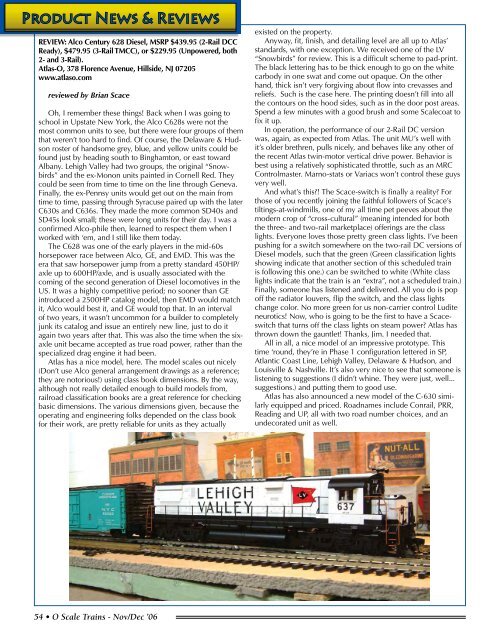O Scale Trains Magazine Online
O Scale Trains Magazine Online
O Scale Trains Magazine Online
- TAGS
- trains
- oscalemag.com
You also want an ePaper? Increase the reach of your titles
YUMPU automatically turns print PDFs into web optimized ePapers that Google loves.
Product News & Reviews<br />
rEviEW: Alco Century 628 Diesel, MsrP $439.95 (2-rail DCC<br />
ready), $479.95 (3-rail tMCC), or $229.95 (unpowered, both<br />
2- and 3-rail).<br />
Atlas-o, 378 Florence Avenue, Hillside, nJ 07205<br />
www.atlaso.com<br />
reviewed by Brian Scace<br />
Oh, I remember these things! Back when I was going to<br />
school in Upstate New York, the Alco C628s were not the<br />
most common units to see, but there were four groups of them<br />
that weren’t too hard to find. Of course, the Delaware & Hudson<br />
roster of handsome grey, blue, and yellow units could be<br />
found just by heading south to Binghamton, or east toward<br />
Albany. Lehigh Valley had two groups, the original “Snowbirds”<br />
and the ex-Monon units painted in Cornell Red. They<br />
could be seen from time to time on the line through Geneva.<br />
Finally, the ex-Pennsy units would get out on the main from<br />
time to time, passing through Syracuse paired up with the later<br />
C630s and C636s. They made the more common SD40s and<br />
SD45s look small; these were long units for their day. I was a<br />
confirmed Alco-phile then, learned to respect them when I<br />
worked with ‘em, and I still like them today.<br />
The C628 was one of the early players in the mid-60s<br />
horsepower race between Alco, GE, and EMD. This was the<br />
era that saw horsepower jump from a pretty standard 450HP/<br />
axle up to 600HP/axle, and is usually associated with the<br />
coming of the second generation of Diesel locomotives in the<br />
US. It was a highly competitive period; no sooner than GE<br />
introduced a 2500HP catalog model, then EMD would match<br />
it, Alco would best it, and GE would top that. In an interval<br />
of two years, it wasn’t uncommon for a builder to completely<br />
junk its catalog and issue an entirely new line, just to do it<br />
again two years after that. This was also the time when the sixaxle<br />
unit became accepted as true road power, rather than the<br />
specialized drag engine it had been.<br />
Atlas has a nice model, here. The model scales out nicely<br />
(Don’t use Alco general arrangement drawings as a reference;<br />
they are notorious!) using class book dimensions. By the way,<br />
although not really detailed enough to build models from,<br />
railroad classification books are a great reference for checking<br />
basic dimensions. The various dimensions given, because the<br />
operating and engineering folks depended on the class book<br />
for their work, are pretty reliable for units as they actually<br />
• O <strong>Scale</strong> <strong>Trains</strong> - Nov/Dec ’06<br />
existed on the property.<br />
Anyway, fit, finish, and detailing level are all up to Atlas’<br />
standards, with one exception. We received one of the LV<br />
“Snowbirds” for review. This is a difficult scheme to pad-print.<br />
The black lettering has to be thick enough to go on the white<br />
carbody in one swat and come out opaque. On the other<br />
hand, thick isn’t very forgiving about flow into crevasses and<br />
reliefs. Such is the case here. The printing doesn’t fill into all<br />
the contours on the hood sides, such as in the door post areas.<br />
Spend a few minutes with a good brush and some <strong>Scale</strong>coat to<br />
fix it up.<br />
In operation, the performance of our 2-Rail DC version<br />
was, again, as expected from Atlas. The unit MU’s well with<br />
it’s older brethren, pulls nicely, and behaves like any other of<br />
the recent Atlas twin-motor vertical drive power. Behavior is<br />
best using a relatively sophisticated throttle, such as an MRC<br />
Controlmaster. Marno-stats or Variacs won’t control these guys<br />
very well.<br />
And what’s this?! The Scace-switch is finally a reality? For<br />
those of you recently joining the faithful followers of Scace’s<br />
tiltings-at-windmills, one of my all time pet peeves about the<br />
modern crop of “cross-cultural” (meaning intended for both<br />
the three- and two-rail marketplace) offerings are the class<br />
lights. Everyone loves those pretty green class lights. I’ve been<br />
pushing for a switch somewhere on the two-rail DC versions of<br />
Diesel models, such that the green (Green classification lights<br />
showing indicate that another section of this scheduled train<br />
is following this one.) can be switched to white (White class<br />
lights indicate that the train is an “extra”, not a scheduled train.)<br />
Finally, someone has listened and delivered. All you do is pop<br />
off the radiator louvers, flip the switch, and the class lights<br />
change color. No more green for us non-carrier control Ludite<br />
neurotics! Now, who is going to be the first to have a Scaceswitch<br />
that turns off the class lights on steam power? Atlas has<br />
thrown down the gauntlet! Thanks, Jim. I needed that.<br />
All in all, a nice model of an impressive prototype. This<br />
time ‘round, they’re in Phase 1 configuration lettered in SP,<br />
Atlantic Coast Line, Lehigh Valley, Delaware & Hudson, and<br />
Louisville & Nashville. It’s also very nice to see that someone is<br />
listening to suggestions (I didn’t whine. They were just, well...<br />
suggestions.) and putting them to good use.<br />
Atlas has also announced a new model of the C-630 similarly<br />
equipped and priced. Roadnames include Conrail, PRR,<br />
Reading and UP, all with two road number choices, and an<br />
undecorated unit as well.

















